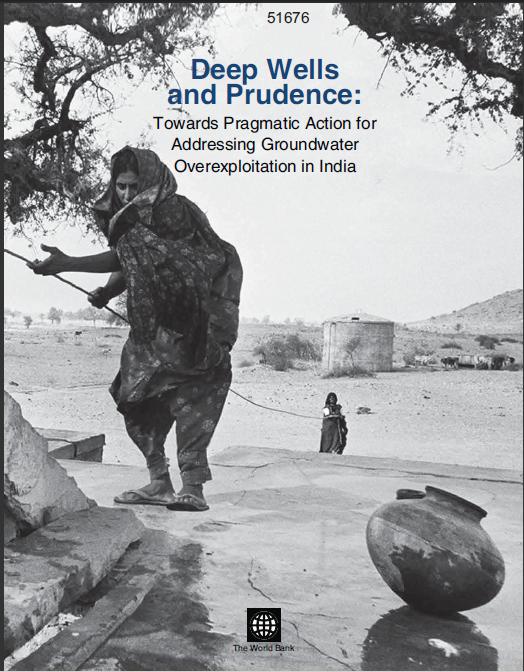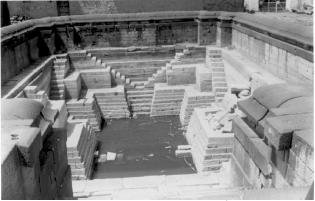Wells and Step-wells
Guidelines for water safety plans for rural water supply systems - A document by SIAES and WHO India (2009)
Posted on 20 Apr, 2011 01:10 AM Delivery of safe drinking water is vital for protecting public health and of promoting more secure livelihoods.
Delivery of safe drinking water is vital for protecting public health and of promoting more secure livelihoods.
The traditional approach to water quality and safety management has relied on the testing of drinking water, as it leaves the treatment works or at selected points, either within the distribution system or at consumer taps. It is referred to as ‘end‐product testing’.
Deep wells and prudence - Towards pragmatic action for addressing groundwater overexploitation in India - A World Bank document (2010)
Posted on 12 Apr, 2011 01:51 AM India is the largest user of groundwater resources in the world. It is estimated that approximately 230 cubic kilometers per year is used annually, this is more than a quarter of the total world consumption from this resource.
India is the largest user of groundwater resources in the world. It is estimated that approximately 230 cubic kilometers per year is used annually, this is more than a quarter of the total world consumption from this resource.
It is in this context that this World Bank report looks at the reasons for this quantum of groundwater usage.
The report delves into socio-economic and political reasons and looks at policies which inadvertently promote so much extraction. The report also analyses various attempts to manage this resource. These attempts range from government and international agency efforts directed to grassroots mobilisations. Finally the report comes out with suggestions to deal with this crisis.
Khazana Bawali - Historical wisdom needing protection - Paper presented at the National Seminar on Water and Culture (2007)
Posted on 14 Feb, 2011 03:57 AMThis paper presents the case of Khazana Bawali - a large ancient well that irrigated around 1000 acres in the past but is now in disrepair. The well is about 20 metres in diameter which stores rainwater from the neighbouring hills. The water is brought through underground tunnels that have ventilators at regular intervals to ensure fresh air and also to help in its manual cleaning. This well today irrigates only about 525 acres. It was built by the Jagirdar of Beed in 1582.
Water management in the Vijaynagar empire - Paper presented at the National Seminar on Water and Culture (2007)
Posted on 14 Feb, 2011 01:55 AMThis paper focuses on water management techniques used in two tanks constructed by the kings of the Vijaynagar Empire.
The first example taken, is that of the Anantraj Sagar built by the son of the minister of Harihar. The lake is still in use and there are inscriptions on stone near it which provide a thumb rule to constructing lakes. Construction of this lake began in 1369 and was completed in 2 years. The paper states that the length of the dam was 5000 dand, width was 8 dand and the height was 7 dand (One dand is about one metre).
Water management systems in the coastal area of Ratnagiri, with special reference to water tanks near temples - Paper presented at the National Seminar on Water and Culture (2007)
Posted on 14 Feb, 2011 01:27 AMThis paper discusses the water management systems found in temples in coastal Konkan, based on a study of 5 temples in the district of Ratnagiri. The study area is a rocky and rugged country, with elevated plateau and intersecting creeks.

Regenerating natural resources and rural livelihoods in rainfed areas of India: A civil society consultation by WASSAN to discuss priorities for the twelfth five year plan
Posted on 26 Jan, 2011 09:13 PM A civil society consultation was held on “Regenerating natural resources and rural livelihoods in rainfed areas of India” by WASSAN at Hyderabad in December 2010 to discuss priorities for the twelfth five year plan. The Planning Commission, Government of India has been steering the process of development in India by conceptualizing five year plans and had sought inputs from civil society organizations, activists groups, networks of CBOs / NGOs, donors and others for preparing an approach paper for twelfth plan.
A civil society consultation was held on “Regenerating natural resources and rural livelihoods in rainfed areas of India” by WASSAN at Hyderabad in December 2010 to discuss priorities for the twelfth five year plan. The Planning Commission, Government of India has been steering the process of development in India by conceptualizing five year plans and had sought inputs from civil society organizations, activists groups, networks of CBOs / NGOs, donors and others for preparing an approach paper for twelfth plan.
The objective of the consultation workshop was to contribute to the process of defining broad contours of twelfth plan with a focus on rural livelihoods the thrust area being policy framework, funding support, institutional arrangements etc., by -
- Consolidating the lessons from good practices in promoting and protecting rural livelihoods in the country, that could be integrated in twelfth five year plan.
- Systematically articulating issues and concerns (bottlenecks) in promoting and protecting rural livelihoods, which could be addressed in the twelfth five year plan.
The need for Scientific Ground Water Investigation Services Survey(SGWISS)
Posted on 18 Jan, 2011 11:50 PMHow SGWISS could support the Rainwater Harvesting?
The main source of sweet water is Rain, but the water available from the rain is not regular and uniformly spread throughout year. So the rainwater could be stored by any method in rain. When the rainwater is stored on the surface but there would not be sufficient capacities of structures developed for the rainwater harvesting. Little quantity of the rainwater is recharged in the subsurface and underground.
Influence of Chalukya architecture on Hampi stepwell - Paper presented at the National Seminar on Water and Culture (2007)
Posted on 29 Dec, 2010 04:16 PM
This paper discusses the reasons for building tanks in ancient India and mentions ancient texts like 'Samarangan Sutradhar' to indicate how wells and other water bodies were constructed.
These water storage systems indicate the knowledge of geology, soil engineering, construction engineering and structural engineering in ancient times.
Saltscapes - Dholavira, Gujarat - A guest post by Amitangshu Acharya and Ayan Ghosh
Posted on 27 Dec, 2010 11:41 PMGuest Post: Text by Amitangshu Acharya, Photographs by Ayan Ghosh
Kachchh – a brilliant halfway between a turmeric yellow Rajasthan and the emerald green Sahyadris – offers an upside down version of life. It tells you that seeds of life and civilisation are often hidden beneath the sands of time in inhospitable terrains.
Guidelines for water safety plans for rural water supply systems by the Sulabh International Academy of Environmental Sanitation
Posted on 27 Dec, 2010 07:20 PMThis document by the Sulabh International Academy of Environmental Sanitation presents the guidelines for water safety plans for rural water supply systems. The revised National Rural Drinking Water Programme (NRDWP) Guidelines 2009-2012 issued by Rajiv Gandhi National Drinking Water Mission, Department of Drinking Water and Sanitation has shifted the focus from source development and installation of water supply system for providing drinking water supply to rural household to focus on development of village security plan.




